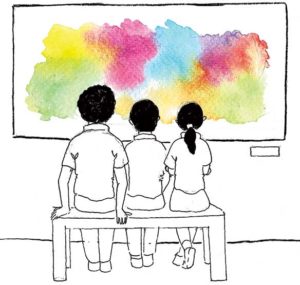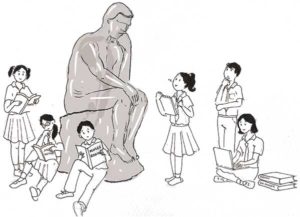Shravan Kumar Pendyala
Visual arts, music, dance and aesthetic studies have been part of our lives supporting its very existence by developing our perceptive abilities. Since prehistoric times to contemporaneity we learnt to perceive “life” through these art forms. Further, these skills of various arts enhanced our lives today. These art forms/subjects (as we call them in academics/institutions) and their categorizations were made based on historical factors and situations. Maybe, understanding the histories of these subjects and how these soft “sciences” have developed human understanding and outlook towards life will make it easier for us to see the nature of these subjects. That it matters to think about them is also important, considering the cognitive, epistemological, psychological, social, economic, and political dimensions around them. Feldman (Feldman, 2002) briefly describes these dimensions in his book, Philosophy of art education, as an individual’s experience, leaving it to the readers to explore the potential of every dimension around art. This needs attention, observation and aptitude (by every individual) to experience the importance of art in our lives.
I would like to quote a few experiences I had concerning the perceptions on art and art education. This will give an idea on how the arts are approached, studied and practiced.
Interaction I: A casual interaction with students outside the classroom as an artist
Teacher: What would you like to become when you grow up?
Student 1: hmm… artist!
Teacher: Why? Artist!
Student 1: Because, artists sell their paintings and they are rich!!
Student 2: No, doctors are rich! I want to be a doctor.
Student 1: Then, I too want to be a DOCTOR!
 It is unpredictable how some casual interactions with students make and mould their ideas. How impactful will they turn out in their lives? But, what they perceive at certain moments in their educational experiences will surely make a difference depending on the skills they acquire and the exposure they get. Nonetheless, their own interest matters. As individuals we have a right to freedom and expression. Why not exercise and execute them in our own lives? While learning, what kind of importance and preferences do we give to different subjects in our schools? This kind of introspection will help us respond to children when they ask questions about career options and livelihood.
It is unpredictable how some casual interactions with students make and mould their ideas. How impactful will they turn out in their lives? But, what they perceive at certain moments in their educational experiences will surely make a difference depending on the skills they acquire and the exposure they get. Nonetheless, their own interest matters. As individuals we have a right to freedom and expression. Why not exercise and execute them in our own lives? While learning, what kind of importance and preferences do we give to different subjects in our schools? This kind of introspection will help us respond to children when they ask questions about career options and livelihood.
How are we reaching out to them? Is it according to our own interests? What do we suggest that they pursue? These questions again remind me of a few more interactions with students, teachers and parents during my field work as an art education researcher.
Interaction II: My experience in the classroom as an art teacher
Teacher: What would you like to do in today’s art class?
Students: Can we do whatever we want to do?
Teacher: ______________________________
I replied in my way but how do teachers reply to such questions or when they get such responses from the students? Is there one specific thing for all of them to work upon? They have their own interests, to work and see for themselves. Then, what will the teacher do with their lesson plans? Here, the pressure built in every classroom on students is varied. The facts, information, content and concepts we want our students to know and understand, maybe build more such tensions and confusions in them which are left unexpressed for “what they want to do or see for themselves”. Instead of bringing clarity to their thoughts, should we spoon-feed what is easier, accessible and prospective? Should these career decisions be made according to an individual’s interests or market demands?
Interaction III: An interaction with an art teacher
An art teacher shares an experience about a parent-teacher meeting and his interaction with a few parents to the researcher.
Art teacher: Today I had a situation… I didn’t know what to say to those parents.
Researcher: What was it like?
Art teacher: A parent asked how her child (girl) was performing in the arts class; and I said she is doing good and improving her skills. They started to complain about her handwriting. To change the topic I started to talk about their boy and his painting skills, and both the parents gave me a look and said he is interested in robotics, sciences and he would become an engineer!!
Here, the aspirations and convictions of the parents foreshadowed their children’s interests in the actual conversation. Contextually, it was meant to discuss the particulars of a learning progress and happenings around the child’s approach in the classroom.
We do not know what career the students will choose, but the parents’ interaction with the teacher about their children’s education lost track. Here the question is, do we want our children to make sense of things around them first or do we want them to gain expertise in and jump into a profession directly? They are learning… they have a choice… they can choose! Have we learnt for ourselves going through such processes in our own lives? Should our concern of the students’ future, as parents and teachers stand in the way of their interests and talents? Should our ideas, concepts and a preconceived notion about various subjects prevent students from thinking during their process of learning?
 Rosenberg and Thurber (Rosenberg & Thurber, 2007) had identified these gender stereotypes, differential roles and expectations created around gender and art education. They argue how every institution of society and family unit contribute to their formation and perpetuation: education, religion, business, politics, the media and others. Rather than seeing all the ways that society is contributing to notions of gender, can we not just focus on schools as a unit, to break through stereotyping* in general about art and artists? Though it is useful to have awareness about the past and older ideas, new interventions through such units might bring in some space to pursue arts without any inhibitions around it.
Rosenberg and Thurber (Rosenberg & Thurber, 2007) had identified these gender stereotypes, differential roles and expectations created around gender and art education. They argue how every institution of society and family unit contribute to their formation and perpetuation: education, religion, business, politics, the media and others. Rather than seeing all the ways that society is contributing to notions of gender, can we not just focus on schools as a unit, to break through stereotyping* in general about art and artists? Though it is useful to have awareness about the past and older ideas, new interventions through such units might bring in some space to pursue arts without any inhibitions around it.
The notion that “not everyone can interpret art” has become a lame excuse to avoid the appreciation and criticism of arts altogether at the school level. The challenges that art education faces are not simply for its placement on a pedestal. Where an expert alone can understand artistic ideas, can we not guide students’ through such processes to enrich their aesthetic senses? Just like the way we put in efforts to make them learn scientific concepts of math and science? In a recent study on art educational practices in Indian school contexts (Pendyala, 2016), observations in the study made a point on time catered to arts in schools, infrastructure provided for its practice and engaging students. It also includes how mainstream subjects like math and science are primarily focused upon by the schools to provide access to higher education later at college and university level. By laying emphasis on the professional careers and specialization at the university level, the ’soft subjects’ have been given a miss or underrated. Most of the soft subjects are considered to be unimportant and math and science are seen as “useful” entry level subjects (Collins, 2011). In addition to this, underperforming students in math and science are encouraged to take up arts for passing out from school at a higher level (Pendyala, 2016). Here the question is, is it easy to identify the “underperforming” students? Or identifying and addressing the student’s “learning style” in those particular subjects, than just labelling the subject itself to be a “soft subject” or “hard subject”, based on our perception? Their application and productivity could be explored at teaching and learning in classrooms.
In the early 1870s, industrialists had recognized the potential that drawing skills required for the market, so that the goods could be sold in an expanding market. This phenomenon had introduced Walter Smith’s idea of imitation, drill and practice (Chapman, 1978) to master drawing skills, and produce draftsmen and designers. Till date, art educators face a major challenge of popular acceptance of an imitation or “representation” as art. Representation or imitation does not involve any originality, making the arts a soft subject.
We have a great example of curiosity and a very popular personality like Leonardo Da Vinci, who is considered a genius in every aspect of the observations he made in his life studies (sketches and drawings) and inventions (Zöllner & Nathan, 2015). His notes speak volumes, be it in understanding the nature of the human body, mechanics or the science behind painting. It is his curiosity and imagination which led him to bring out the best in him. Can we add such curiosity and imagination to these soft subjects like visual arts, performing arts, design and technology, music and dance to make them more subtle to pursue and practice and call them “subjects” for life-long learning?
*For an excellent photographic essay on stereotypes, see John Berger, Ways of Seeing (New York: Viking Press, 1972).
References
- Chapman, L. H. (1978). Approaches to Art Education. New York: Harcourt Brace Jovanovich, Inc.
- Collins, N. (2011, February 04). Universities tell students the ‘soft’ subjects to avoid. Retrieved September Sunday, 2018, from www.telegraph.co.uk; https://www.telegraph.co.uk/education/universityeducation/8302536/Universities-tell-students-the-soft-subjects-to-avoid.html
- Feldman, E. B. (2002). Philosophy of Art Education. NJ: PRENTICE HALL.
- Pendyala, S. k. (2016). Investigating Art Teacher Practices of Middle Schools in Hyderabad. Hyderabad: Unpublished.
- Rosenberg, M., & Thurber, F. (2007). Gender Matters in Art Education. Massachusetts: Davis Publications, Inc.
- Zöllner, F., & Nathan, J. (2015). Leonardo Da Vinci: The Complete Paintings and Drawings. Cologne: Taschen.
The author is pursuing his Ph.D. at Tata Institute of Social Sciences, Hyderabad. He is also an art practitioner with varied interests in art and education. He can be reached at shravankumarpendyala@gmail.com.
Related Articles
Of skills, learning, intelligences and … the marketplace
Unweaving the rainbow
Debunking the math myth
